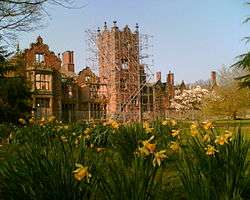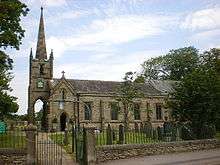Listed buildings in Bretherton
Bretherton is a civil parish in the Borough of Chorley, Lancashire, England. The parish contains 18 buildings that are recorded in the National Heritage List for England as designated listed buildings. Of these, two are listed at Grade II*, the middle grade, and the others are at Grade II, the lowest grade. Apart from the village of Bretherton, the parish is rural. Most of the listed buildings are, or originated as, farmhouses or farm buildings. The other listed buildings include a medieval cross base, two historic houses, a cottages, a former school a converted windmill, a church, and a rectory.
Key
| Grade | Criteria[1] |
|---|---|
| II* | Particularly important buildings of more than special interest |
| II | Buildings of national importance and special interest |
Buildings
| Name and location | Photograph | Date | Notes | Grade |
|---|---|---|---|---|
| Cross base 53°40′38″N 2°47′39″W / 53.67728°N 2.79412°W |
— |
Medieval (probable) | The stone base of a former cross, about 1 metre (3 ft 3 in) high, square and with tapered sides. In the upper surface is a filled-in circular recess.[2] | II |
| Bank Hall 53°40′32″N 2°48′54″W / 53.67558°N 2.81511°W |
 |
1608 | A Jacobean mansion that was extended later in the 16th century, and altered, restored and extended in 1832–33, probably by George Webster. By the late 20th century the building had become derelict. It is built in red brick with diapering,and has stone dressings and slate roofs. The house is mainly in 2 1⁄2 storeys, its most prominent feature being the square tower, which contains mullioned and transomed windows, and a clock face, and has an ornamental parapet. Features in the other remaining parts include Dutch gables, and chimney stacks with clustered diagonal flues.[3][4] | II* |
| Carr House 53°41′13″N 2°48′54″W / 53.68696°N 2.81505°W |
 |
1613 | A house in red brick with blue brick diapering, stone dressings, and a slate roof that was remodelled in the 20th century. It has 2 1⁄2 storeys, is in an E-shaped plan, and has a symmetrical five-bay front. The outer bays project slightly forward, and in the centre is a three-storey porch. Above the doorway in the porch is a large inscribed lintel. The windows are mullioned. Inside the house is a cruck roof, an inglenook fireplace, and a timber bressumer.[5][6] | II* |
| Blackamoor Hall 53°40′38″N 2°47′55″W / 53.67726°N 2.79849°W |
— |
Early 17th century (probable) | Originally a farmhouse, it is in brick with some diapering, stone quoins, and a slate roof. The house has two storeys and is in a T-shaped plan with a two bay range and a two-bay cross-wing. All the openings have been altered.[7] | II |
| Iron Barn Farmhouse 53°40′40″N 2°47′22″W / 53.67778°N 2.78950°W |
— |
Early 17th century | A brick farmhouse on a sandstone plinth with a stone-slate roof at the front, and a slate roof at the rear. It has two storeys and three bays, with additions to the front and rear of the first bay. On the front is a gabled porch and sliding sash windows, and at the rear all the windows have been altered.[8] | II |
| Farm building, Bank Hall 53°40′36″N 2°48′58″W / 53.67673°N 2.81603°W |
— |
17th century | A multi-purpose farm building in brick with stone quoins and a stone-slate roof. It has a rectangular plan, and is about 75 metres (246 ft) long. The building contains windows, stable doors, a wagon doorway, ventilation slits, and loading doors.[9] | II |
| Smithy Cottage 53°40′56″N 2°47′32″W / 53.68212°N 2.79218°W |
— |
17th century (probable) | A cruck-framed cottage with brick cladding on a rendered plinth and with a corrugated sheet roof, It is in 1 1⁄2 storeys, and has a three-bay front. On the front is a modern gabled porch, and the windows are casements. On the rear is a sliding sash window.[10] | II |
| 152 and 154 South Road 53°40′39″N 2°47′39″W / 53.67752°N 2.79412°W |
— |
1653 | Originally a school, later converted into two houses, it is in roughcast brick with a slate roof, and has a rectangular plan. There are two storeys and a three-bay front. On the front is a gabled porch, with an inscribed lintel above the doorway. The windows are 19th-century sashes.[11][12] | II |
| Holly Farmhouse 53°40′37″N 2°47′46″W / 53.67694°N 2.79617°W |
— |
Late 17th century (probable) | Originally a farmhouse, it is in brick with a stone-slate roof. The house has two storeys and three bays, and contains sliding sash windows. In the right gable are external steps leading to a former loft. Inside the building is an inglenook.[13] | II |
| White House Farmhouse 53°40′55″N 2°47′48″W / 53.68200°N 2.79665°W |
— |
1680 | The farmhouse is in brick, partly whitewashed, partly rendered, with stone quoins and a slate roof. It has two storeys and a three-bay front. On the front is a two-storey porch with a round-headed entrance containing stone benches. The windows are casements.[14] | II |
| Church House Farmhouse 53°40′38″N 2°47′38″W / 53.67712°N 2.79401°W |
— |
1698 | The former farmhouse is in brick on a plinth, with stone quoins and a stone-slate roof. It has two storeys and a three-bay front, with a single-storey extension at the rear of the third bay. On the front is a two-storey gabled porch containing a segmental-headed doorway with a datestone above. Most of the glazing has been altered. Inside the house is an inglenook and a bressumer.[15] | II |
| Farmhouse 53°40′54″N 2°48′01″W / 53.68178°N 2.80026°W |
— |
1702 | A brick farmhouse with a corrugated iron roof, it has two storeys and a three-bay front. On the front is a two-storey gabled porch and a datestone. Most of the windows have been altered; on the front there is a mullioned window and some casements, and on the rear are sliding sash windows.[16] | II |
| Martinside Farmhouse 53°40′37″N 2°47′42″W / 53.67693°N 2.79509°W |
— |
1718 (or earlier) | The former farmhouse is in brick with blue brick diapering and it has a stone-slate roof. The house has an L-shaped plan consisting of a two-bay main range and a projection porch wing on the right side. | II |
| Windmill 53°40′51″N 2°48′56″W / 53.68086°N 2.81563°W |
— |
1741 | The former windmill has been converted into a house. It is in rendered brick with a wooden cap. The building has three tapering storeys, and has a modern door and windows. On the northwest side is a cruciform iron plate for the former sails.[11][17] | II |
| Barn, Blackamoor Hall 53°40′38″N 2°47′53″W / 53.67732°N 2.79798°W |
— |
18th century (probable) | The barn is mainly in brick, with some sandstone, and has a roof of blue slate with some red tiles. It has a long rectangular plan, and is in probably five bays. It contains a wagon entrance, doorways, windows, a round pitching hole, and ventilation holes in diamond patterns.[18] | II |
| Barn, Copeland Farm 53°40′41″N 2°46′55″W / 53.67812°N 2.78207°W |
— |
1779 | A brick barn with a stone-slate roof in a rectangular plan. It contains ventilation holes in a diamond pattern, doorways, and windows. On the north side is a wagon doorway, and in the east gable are an inscribed lintel, a circular pitching hole, and an owl hole.[19] | II |
| St John the Baptist's Church 53°40′40″N 2°47′42″W / 53.67771°N 2.79508°W |
 |
1840 | A Commissioners' Church that was designed by Edmund Sharpe, and restored by his successors Austin and Paley in 1898, who also added the chancel and vestry in 1908–09. It is built in sandstone with slate roofs, and is mainly in Perpendicular style. The church consists of a five-bay nave with a south porch, a two-bay chancel, and a slender west steeple. The steeple has a tower with a porch that is open to the north and south, diagonal buttresses, a stepped parapet with crocketed pinnacles on the corners, and a slim octagonal spire.[20][21][22] | II |
| Rectory 53°40′39″N 2°47′40″W / 53.67762°N 2.79452°W |
— |
1840 (probable) | The rectory is in red brick with sandstone dressings and a slate roof, and is in Jacobean style. There are two storeys and a symmetrical three-bay front. In the front is a central Tudor arched doorway with a fanlight, and the windows are sashes.[11][23] | II |
References
Citations
- ↑ Historic England
- ↑ Historic England (1072571)
- ↑ Hartwell & Pevsner (2009), pp. 169–170
- ↑ Historic England (1362113)
- ↑ Hartwell & Pevsner (2009), p. 170
- ↑ Historic England (1163160)
- ↑ Historic England (1163212)
- ↑ Historic England (1072569)
- ↑ Historic England (1163194)
- ↑ Historic England (1072567)
- 1 2 3 Hartwell & Pevsner (2009), p. 169
- ↑ Historic England (1072570)
- ↑ Historic England (1163230)
- ↑ Historic England (1163201)
- ↑ Historic England (1309232)
- ↑ Historic England (1072568)
- ↑ Historic England (1163172)
- ↑ Historic England (1362114)
- ↑ Historic England (1072566)
- ↑ Hartwell & Pevsner (2009), pp. 168–169
- ↑ Brandwood et al. (2012), pp. 211, 242, 247
- ↑ Historic England (1362115)
- ↑ Historic England (1163234)
Sources
- Brandwood, Geoff; Austin, Tim; Hughes, John; Price, James (2012), The Architecture of Sharpe, Paley and Austin, Swindon: English Heritage, ISBN 978-1-84802-049-8
- Hartwell, Clare; Pevsner, Nikolaus (2009) [1969], Lancashire: North, The Buildings of England, New Haven and London: Yale University Press, ISBN 978-0-300-12667-9
- Historic England, "Base of cross on south side of road at corner of drive to Church House Farmhouse, Bretherton (1072571)", National Heritage List for England, retrieved 26 January 2015
- Historic England, "Bank Hall, Bretherton (1362113)", National Heritage List for England, retrieved 26 January 2015
- Historic England, "Carr House, Bretherton (1163160)", National Heritage List for England, retrieved 26 January 2015
- Historic England, "Blackamoor Hall, Bretherton (1163212)", National Heritage List for England, retrieved 26 January 2015
- Historic England, "Iron Barn Farmhouse, Bretherton (1072569)", National Heritage List for England, retrieved 26 January 2015
- Historic England, "Farm building, the southern of 2 parallel ranges c.100 metres west of Bank Hall Farmhouse, Bretherton (1163194)", National Heritage List for England, retrieved 26 January 2015
- Historic England, "Smithy Cottage, Bretherton (1072567)", National Heritage List for England, retrieved 26 January 2015
- Historic England, "Nos. 152 and 154 South Road, Bretherton (1072570)", National Heritage List for England, retrieved 26 January 2015
- Historic England, "Holly Farmhouse, Bretherton (1163230)", National Heritage List for England, retrieved 26 January 2015
- Historic England, "White House Farmhouse, Bretherton (1163201)", National Heritage List for England, retrieved 26 January 2015
- Historic England, "Church House Farmhouse, Bretherton (1309232)", National Heritage List for England, retrieved 27 January 2015
- Historic England, "Farmhouse c.20m east of Watson Cottage, Bretherton (1072568)", National Heritage List for England, retrieved 26 January 2015
- Historic England, "The Old Windmill, near Bank Hall, Bretherton (1163172)", National Heritage List for England, retrieved 26 January 2015
- Historic England, "Barn c.30 metres north east of Blackamoor Hall, Bretherton (1362114)", National Heritage List for England, retrieved 27 January 2015
- Historic England, "Barn c.30m west of Copeland Farmhouse, Bretherton (1072566)", National Heritage List for England, retrieved 26 January 2015
- Historic England, "Church of St. John the Baptist, Bretherton (1362115)", National Heritage List for England, retrieved 27 January 2015
- Historic England, "Rectory, Bretherton (1163234)", National Heritage List for England, retrieved 26 January 2015
- Historic England, Listed Buildings, retrieved 26 January 2015
This article is issued from Wikipedia - version of the 4/10/2016. The text is available under the Creative Commons Attribution/Share Alike but additional terms may apply for the media files.